I had a great time in October 2023. I spent most of that month outdoors, wandering around woods and meadows. The weather was kind, the vegetation still lush, and the insects abounded. There was so much to see and photograph.
On the 23rd of October, I spent a couple of hours in the forest around the archeological park of Nesactium. In this opening photograph, you can take a good look at the scenery before I dive into the details and macro.
This is the Lygus pratensis ...
... a bug from the Miridae family. I found it on the juicy leaves covered with dense short trichomes ...
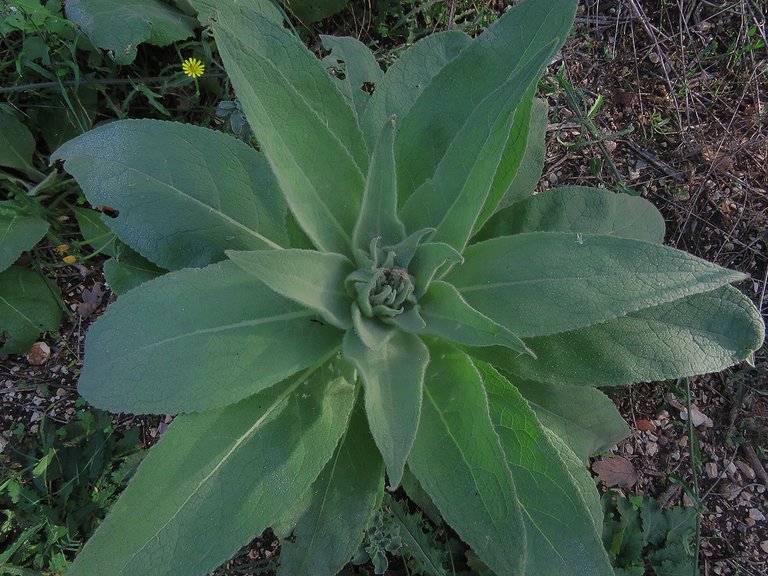
... the leaves of the Verbascum densiflorum plant.

This leafhopper (Cicadellidae family) was photographed on the same plant.
I can't tell you the name of the species. Could be the Aphrodes carinatus. I'm pretty sure that the genus is Aphrodes. The insect shown in the above photograph is a fully developed adult.
A bit later, always on the Verbascum densiflorum leaves ...

... I found a nymph of another leafhopper.

Don't ask me what species this is. In their nymphal stage, quite a few leafhoppers present in this area look more or less the same. The family is Cicadellidae, that's little but sure. Meanwhile ...
... on another leaf of the same plant ...
... a small, juvenile Oxyopes heterophthalmus was waiting for a potential prey to pass by. Oxyopes heterophthalmus is a spider from the Oxyopidae family.
Verbascum densiflorum plant sometimes resembles a tower whose each floor has something different to offer to a macrophotography enthusiast. Here you can see the Longitarsus exoletus, a beetle from the Chrysomelidae family chewing the tissue on the upper surface of the leaf.
In this and the following five photographs ...
... the focus is on the Lygus pratensis bug again.
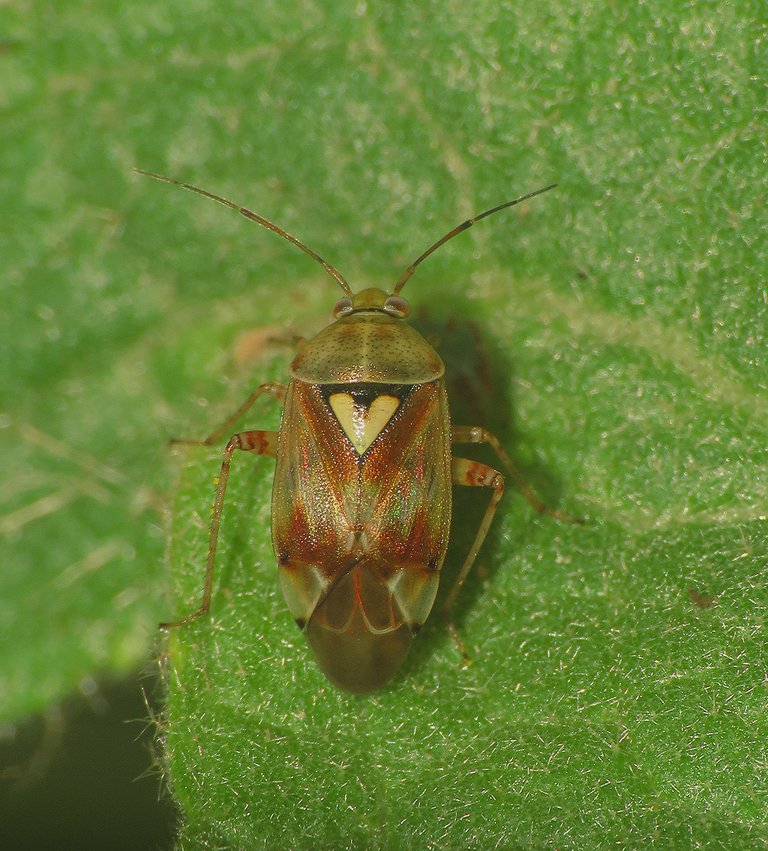
I can't remember why I took so many photographs while the bug was resting.
Maybe I was especially inspired or I did it only becouse it was easy.

This small spider ...

... that resembled a tiny fruit, seed, or body part of an insect caught on the silky thread ...
... was hanging on the large web of a much bigger spider.
This is the Araneus diadematus, a spider from the Araneidae family.
Here you can see the tiny spider climbing the thread.
The name of the species is Argyrodes argyrodes. It belongs to the Theridiidae family.
All spiders from the genus Argyrodes form interesting kleptoparasitic relationships with other spiders, I mean with other, prevalently orb-weaving species.
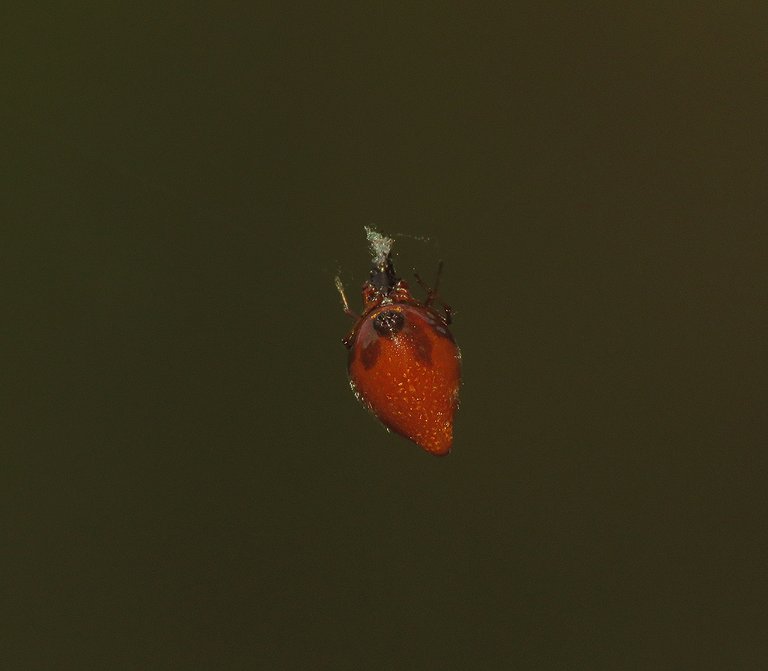
They can spin their webs but tend to invade and reside in the webs of other spiders.
They often feed on small prey that bigger spiders don't consider interesting or on what remains after their meals but if an Argyrodes invades the living space of a small spider it will chase the host from its prey or even attack and eat the resident spider.
In this set of four photographs, you can see the Argyrodes argyrodes climbing one of the threads on the edge of the web ...
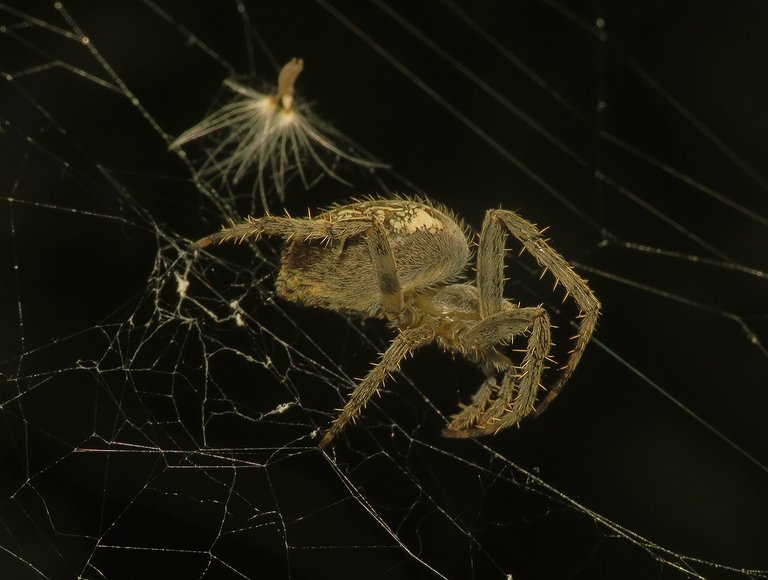
... while the Araneus diadematus is resting in its center.
The Argyrodes argyrodes has reached the dry stem of one of the plants that provided a solid frame for the pretty large web.
It was time for me to leave the tiny kleptoparasite and the big, robust host to continue exploring the edge of the forest.
The plant shown in this tryptich is the Osyris alba, a hemiparasitic shrub that gets some of its nutrients through the roots of the surrounding trees.
This bug from the Coreidae family ...
... was resting on the relatively large, ovate leaf of the Corylus avellana shrub. This very useful plant is commonly known as the common hazel.
Regarding the bug, the name of the species is Gonocerus acuteangulatus.
Among the branches of the common hazel, the Fallopia dumetorum bindweed was growing. I photographed only the small fruits of that plant. In the following shot ...
... you can see the same scene in a different light. Here I used the small, built-in flash of my Canon PowerShot SX60 HS camera. The fruits look better in ambient light, of course, but the flash helps reveal some cool details.
This small leaf, covered with tiny droplets ...
... was found and photographed near the neat line of much bigger plants shown in this shot. The large leaves belong to Salvia pratensis and Verbascum densiflorum.

The small leaf, photographed in ambient light in this shot, belongs to the Ranunculus tuberosus. In the following photograph ...
... I'm presenting the droplets in all their tiny majesty. I used the macro lens to get this shot.
Mornings were very humid in those days. The dew used to disappear an hour or two before noon but in shady places, it was decorating the small herbaceous plants the whole day round.
In the above photograph, you can see the Euphorbia cyparissias spurge.

Here you can see a group of slightly humid seeds of the Hieracium amplexicaule plant.
The same seeds were photographed with the flash in this shot.

Here you can see another group of Hieracium amplexicaule seeds. A little less than a meter above them ...
... on the dry stem of some pretty tall herbaceous plant that I wasn't able to identify, I found this bug from the Rhyparochromidae family.

The name of the species is Rhyparochromus vulgaris.
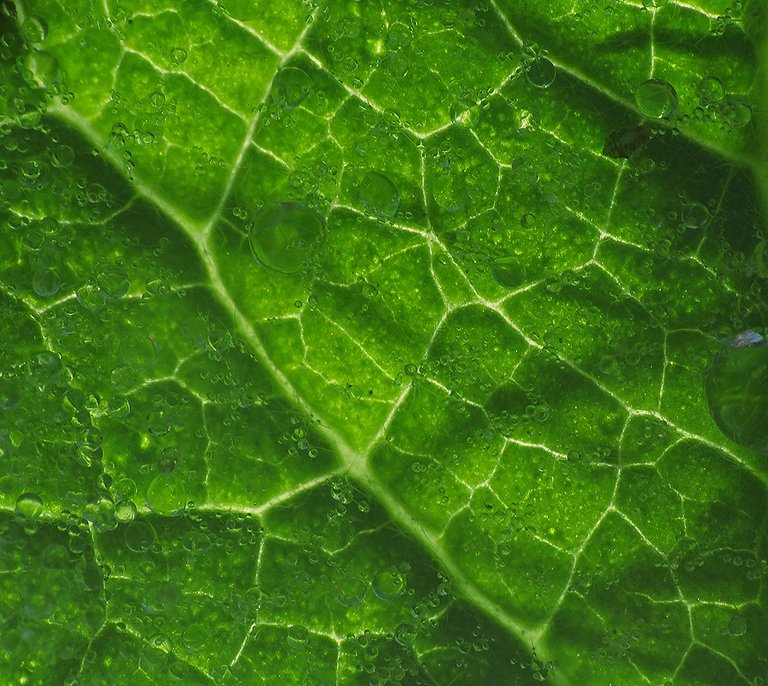
Here you can see the dew on a leaf illuminated by the sun. Can't tell you the name of the plant.

On the piece of wood that was rotting in the same humid area, I found a group of young Stereum hirsutum fruiting bodies.
Stereum hirsutum is a fungus from the Stereaceae family.
Here you can see a group of very young plants that recently sprouted on dried-out but currently well-soaked flowerhead of the Trifolium lappaceum clover. In the following photograph ...
... I came a bit closer to those baby plants.
Here you can see the same thing shown from a slightly different angle.
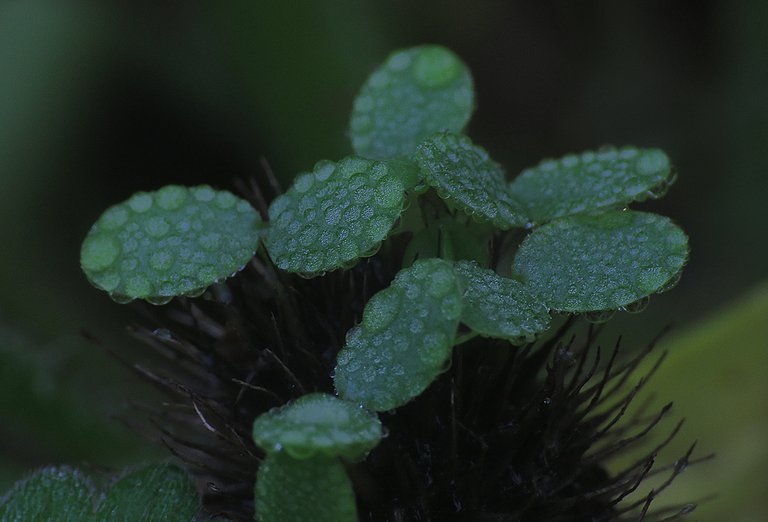
This shot was taken in the pretty low ambient light. Dew looks great when illuminated with a subdued diffuse light.
Here you can see a tiny, recently sprouted plant that started developing its root on the upper surface of a relatively large leaf of another plant. Less than a meter from this interesting herbal arrangement...
... Ablattaria laevigata was climbing the twigs of something that looked like a very young shrub or tree.
Ablattaria laevigata is a snail-hunting beetle from the Silphidae family.
Both adults and larvae of this species can penetrate the shells of various terrestrial snails.
Here you can take another look at the scenery on the edge of the woods. Many trees were partially covered with ivy (Hedera helix).

I found three interesting arthropods on the leaves of that climbing plant. This is the first one. The Otiorhynchus cardiniger. A weevil from the Curculionidae family.
Here you can see a red mite from the Trombidiidae family. Can't tell you what species exactly is this.
This lovely bug belongs to the Lygaeidae family. The name of the species is Melanocoryphus albomaculatus.
Here you can take a look at the Ruscus aculeatus, the thorny shrub that grows in the shade of the trees.
Here you can see its fruits photographed in natural light. In the following photograph ...
... I used the flash to illuminate the things in the shade and accentuate the red berries.
In some places deeper in the woods the growth of these shrubs is very dense and covers relatively large patches of terrain. The sturdy thorns make a walk through those areas pretty painful if one doesn't have thick pants, high boots, or both.
This is the Parasola auricoma mushroom.
The cap of this young fruiting body still isn't fully developed.
A meter or two further ...
... I came across a fully developed Parasola auricoma ...
... with a cap that resembles a lovely little umbrella or some kind of jellyfish.
In a sunny spot further from the shrubs and trees ...
... I photographed a Picris hieracioides flower surrounded by cypress spurge.
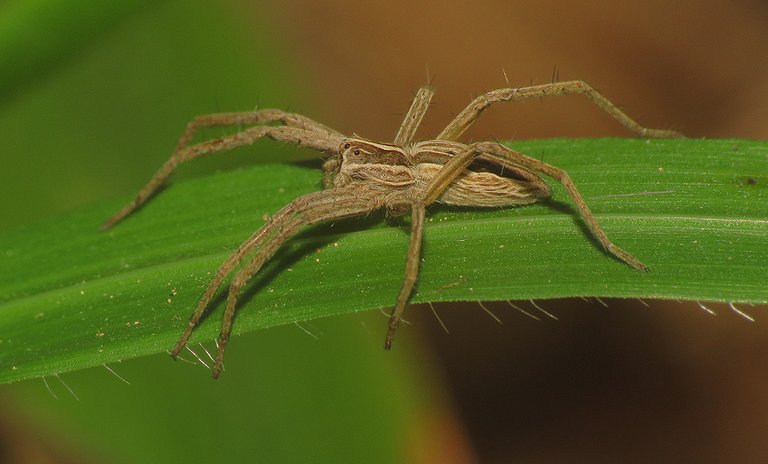
A Pisaura mirabilis spider was resting on a blade of grass in the shade not far from there.
Here you can take a look at the Cornus sanguinea shrubs. The foliage was still prevalently green but I saw a few autumnally colored branches on the 23rd of October 2023.
This is the Nomophila noctuella, a moth from the Crambidae family. I photographed it five or six meters further on some shrubs that I'm not able to identify today becouse I forgot to take a few shots that show a complete leaf, fruit, seed, or flower of the plant on which the insect was resting.
Here you can see the sprouts of an Ulmus glabra tree.
This lovely, partially eaten flower ...
... that resembles a little star ...
... belongs to the Solanum nigrum plant. In this photograph, you can see its fruits, while the following shot ...
... shows a group of these plants in the shade of the trees.
Solanum nigrum is a very common plant here in my area. I encounter it so often that more often than not, I just don't bother to look at it. However, back on the 23rd of October 2013, something about these plants caught my attention.
It was great to see in one place so many flowers and fruits in various stages of development. I saw partially open flowers ...
... I saw completely developed flowers ...
... and quite a few flower buds too.
Here you can see a green, unripe fruit.
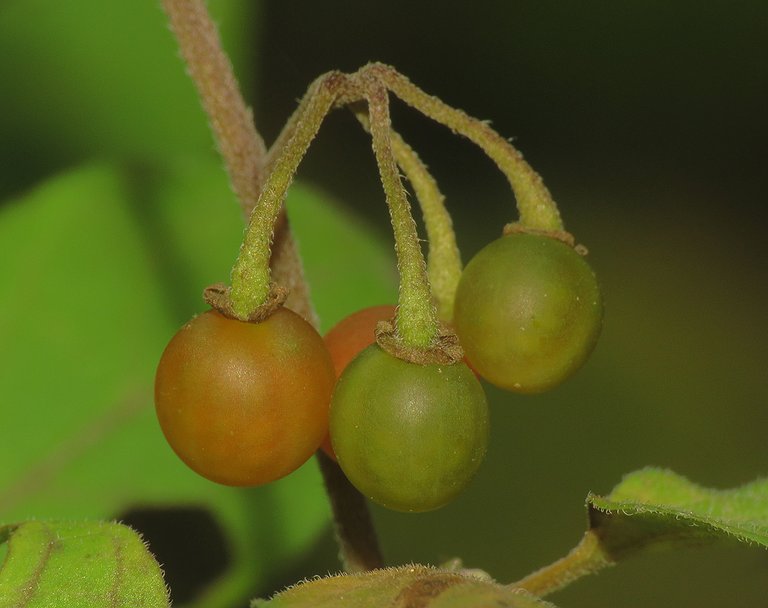
Two of the four fruits shown in this photograph are orange which means that they are further on their way to ripening.
Here you can see two more intensely orange-colored fruits. These are even more ripe than the ones shown in the previous photograph.
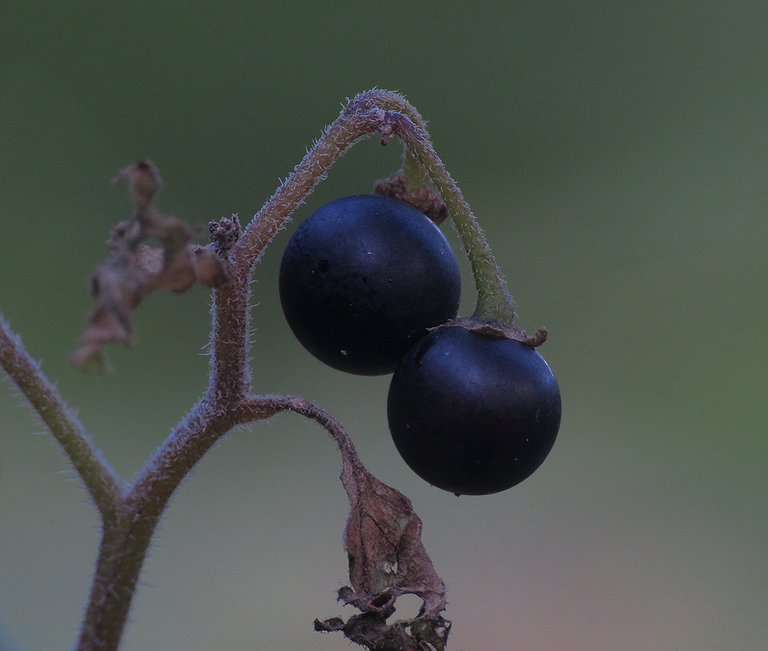
Completely developed, ripe fruits of the Solanum nigrum plant are black.

This green, unripe fruit looked pretty cool among the brown leaves and stems of a dry Solanum nigrum plant. That's why this photograph is here.

In this shot, you can see the small fly that was resting on one of the green Solanum nigrum leaves. Can't tell you the name of the species.
Here you can see yet another Solanum nigrum flower. and a flower bud next to it.
This flower still hasn't spread its petals properly.
Yep. I definitely photographed quite a few Solanum nigrum flowers that afternoon.
These green, unripe berries belong to a plant closely related to Solanum nigrum. The name of this species is Solanum dulcamara. These fruits will be vivid red when they ripen.
AND THAT'S IT. AS ALWAYS HERE ON HIVE, THE PHOTOGRAPHS ARE MY WORK.
The following links will take you to the sites with more information about some of the protagonists of today's post. I found some stuff about them there.
https://en.wikipedia.org/wiki/Lygus_pratensis
https://en.wikipedia.org/wiki/Verbascum_densiflorum
https://en.wikipedia.org/wiki/Aphrodes
https://en.wikipedia.org/wiki/Oxyopes_heterophthalmus
https://en.wikipedia.org/wiki/Longitarsus_exsoletus
https://en.wikipedia.org/wiki/Araneus_diadematus
https://en.wikipedia.org/wiki/Argyrodes
https://en.wikipedia.org/wiki/Osyris_alba
https://en.wikipedia.org/wiki/Corylus_avellana
https://en.wikipedia.org/wiki/Gonocerus_acuteangulatus
https://en.wikipedia.org/wiki/Fallopia_dumetorum
https://en.wikipedia.org/wiki/Salvia_pratensis
https://uk.inaturalist.org/taxa/481305-Ranunculus-tuberosus
https://en.wikipedia.org/wiki/Euphorbia_cyparissias
https://en.wikipedia.org/wiki/Hieracium_amplexicaule
https://en.wikipedia.org/wiki/Rhyparochromus_vulgaris
https://en.wikipedia.org/wiki/Stereum_hirsutum
https://en.wikipedia.org/wiki/Trifolium_lappaceum
https://en.wikipedia.org/wiki/Ablattaria_laevigata
https://en.wikipedia.org/wiki/Hedera_helix
https://uk.inaturalist.org/taxa/952488-Otiorhynchus
https://www.flickr.com/photos/22541431@N04/39435836365
https://en.wikipedia.org/wiki/Trombidiidae
https://en.wikipedia.org/wiki/Melanocoryphus_albomaculatus
https://en.wikipedia.org/wiki/Ruscus_aculeatus
https://en.wikipedia.org/wiki/Parasola_auricoma
https://en.wikipedia.org/wiki/Picris_hieracioides
https://en.wikipedia.org/wiki/Pisaura_mirabilis
https://en.wikipedia.org/wiki/Cornus_sanguinea
https://en.wikipedia.org/wiki/Nomophila_noctuella
https://en.wikipedia.org/wiki/Ulmus_glabra
https://en.wikipedia.org/wiki/Solanum_nigrum
https://en.wikipedia.org/wiki/Solanum_dulcamara
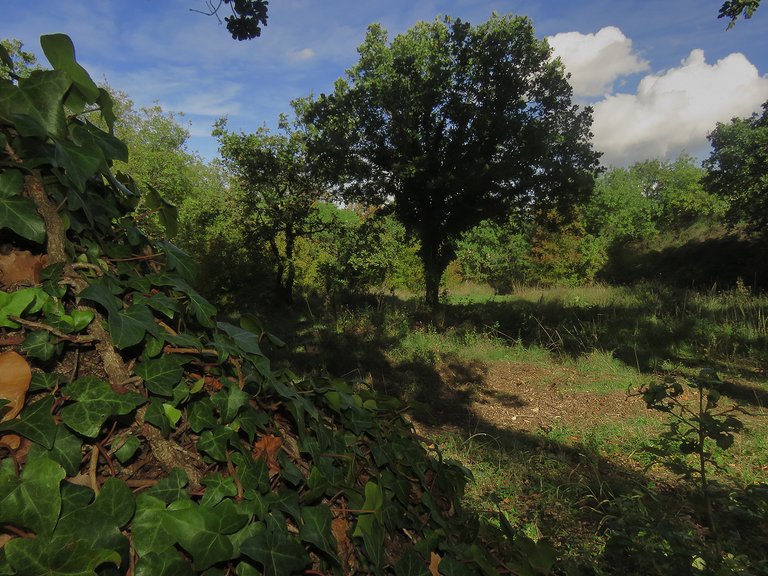
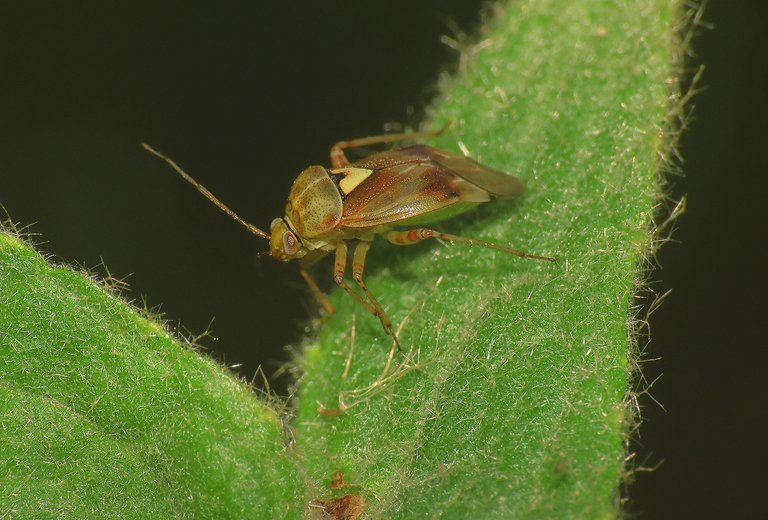



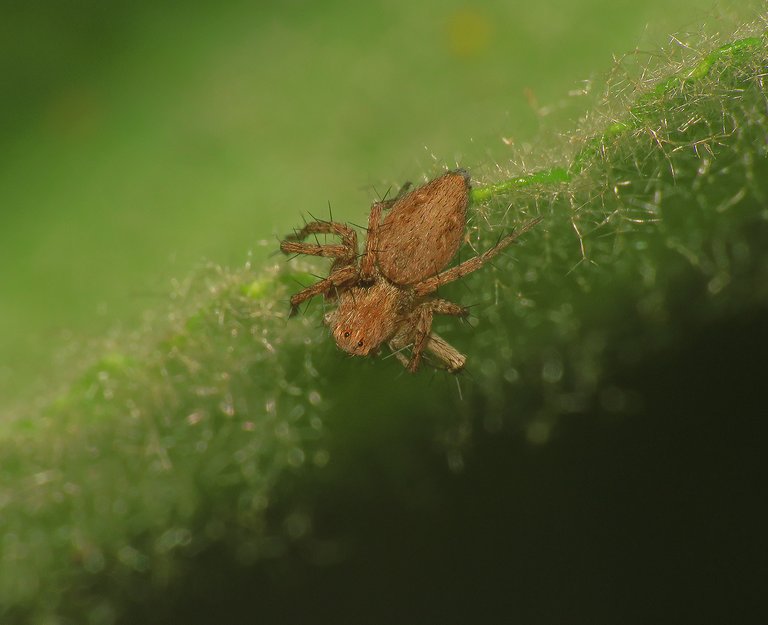




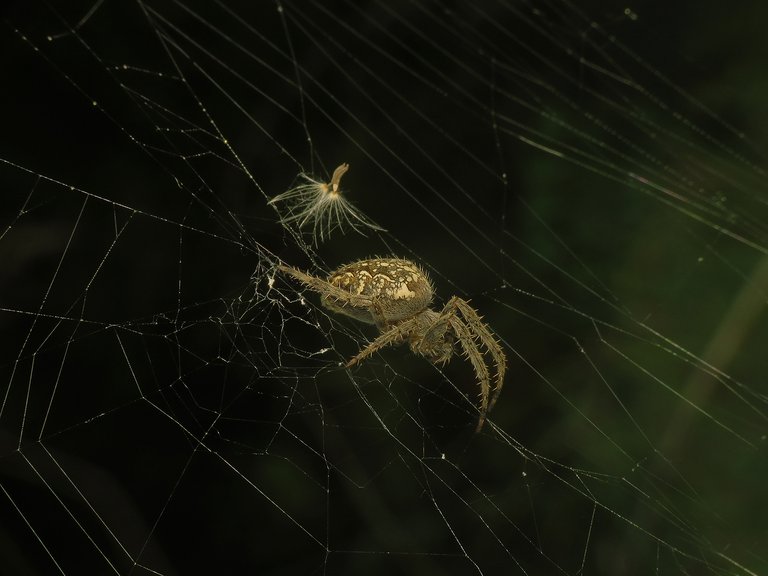
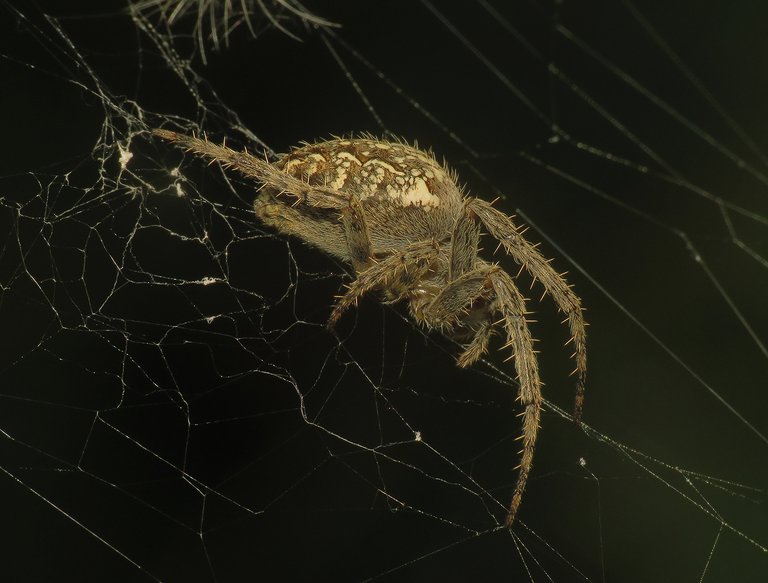



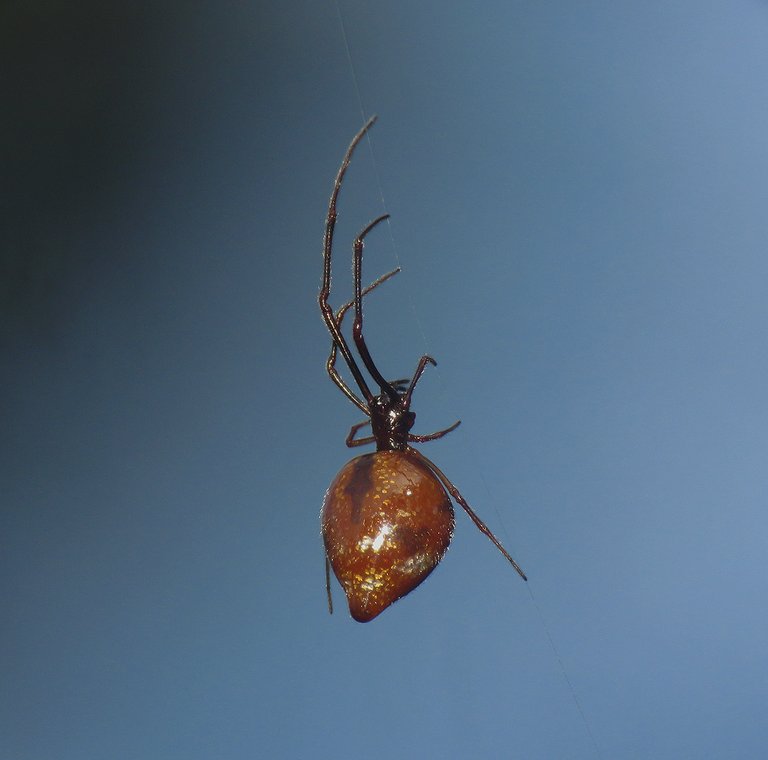
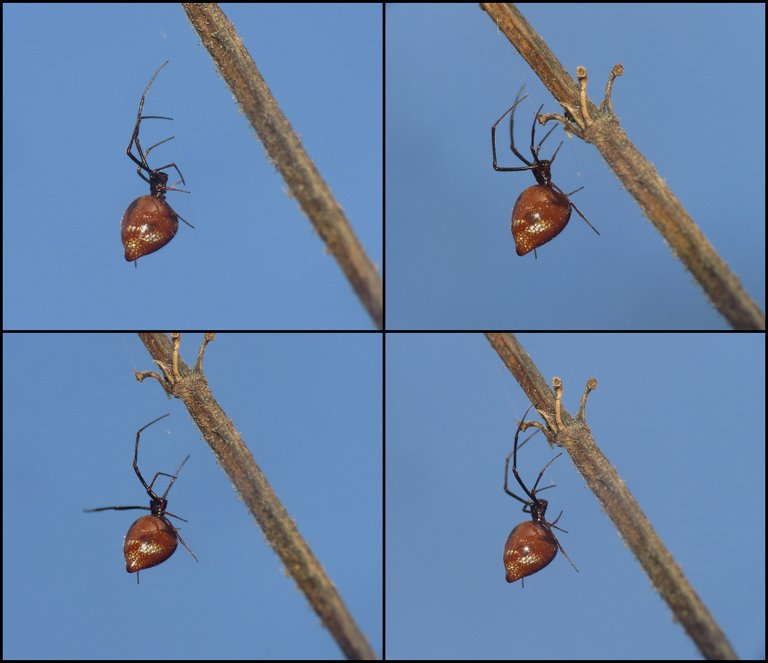





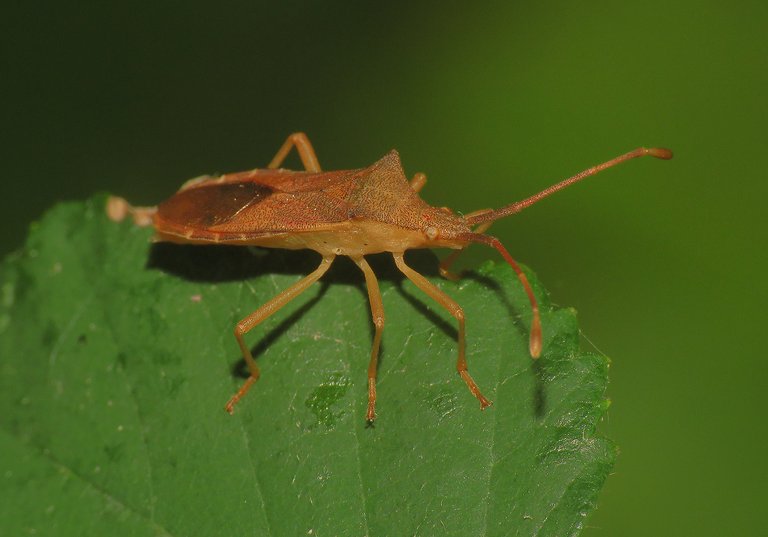
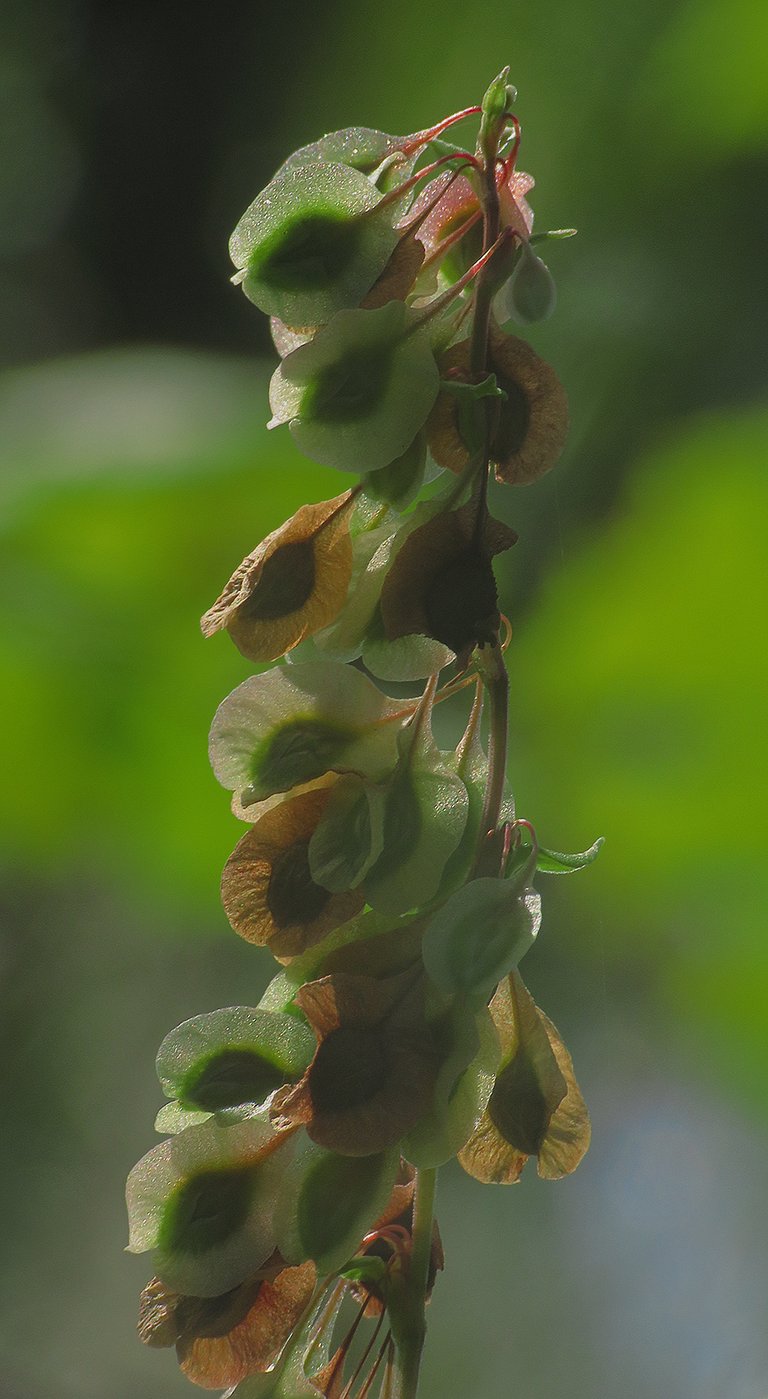
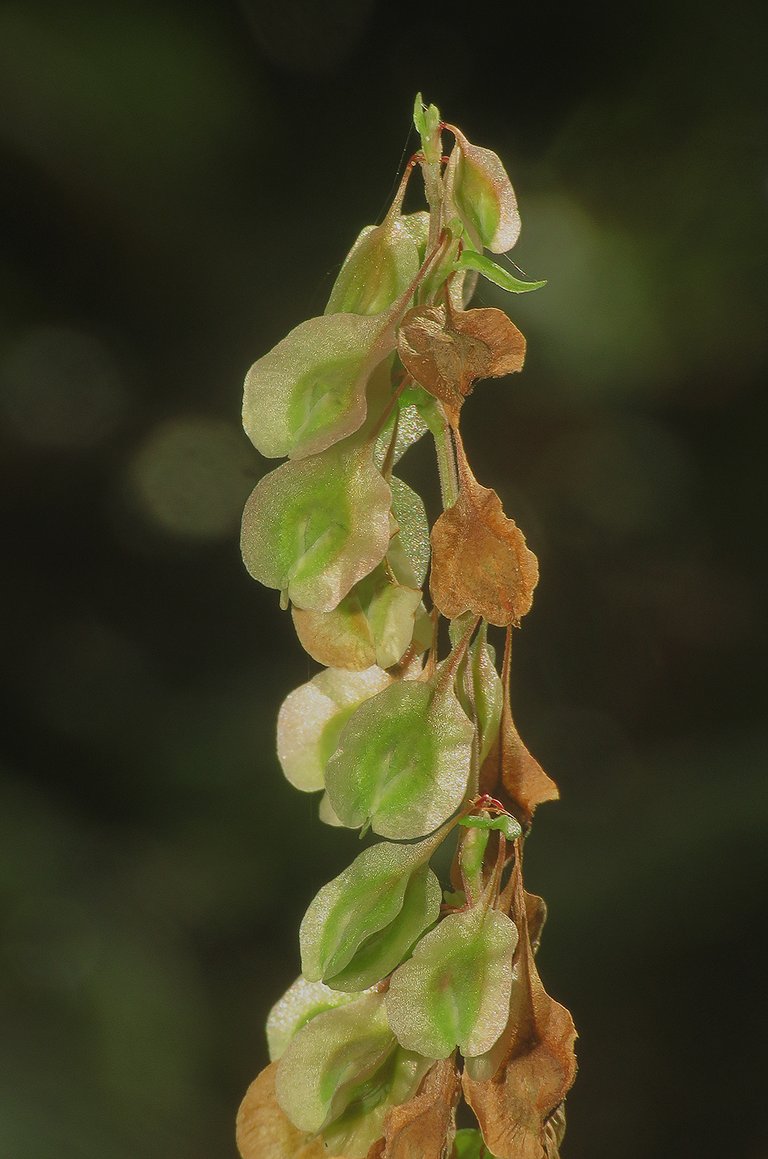
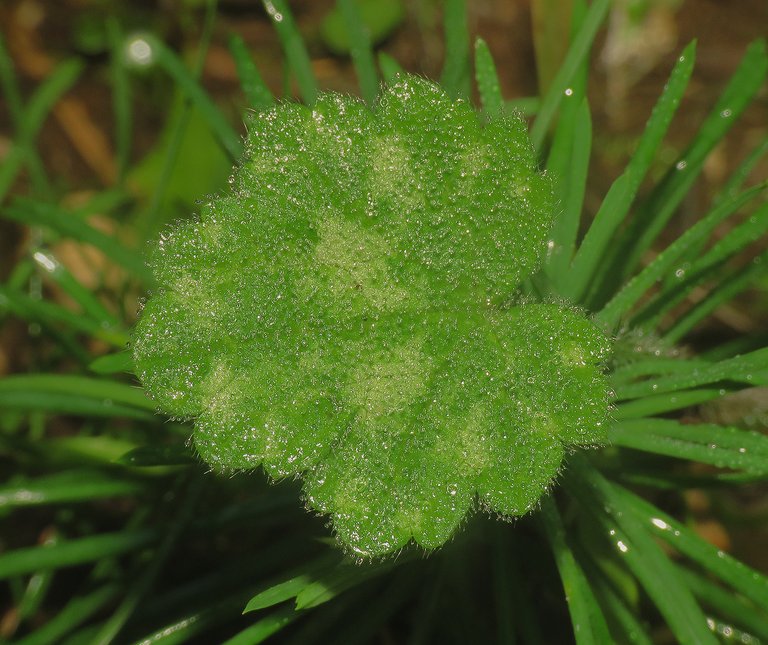



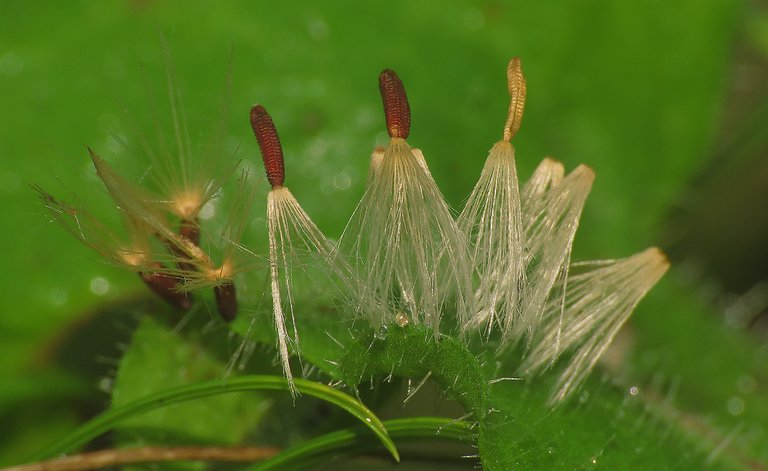



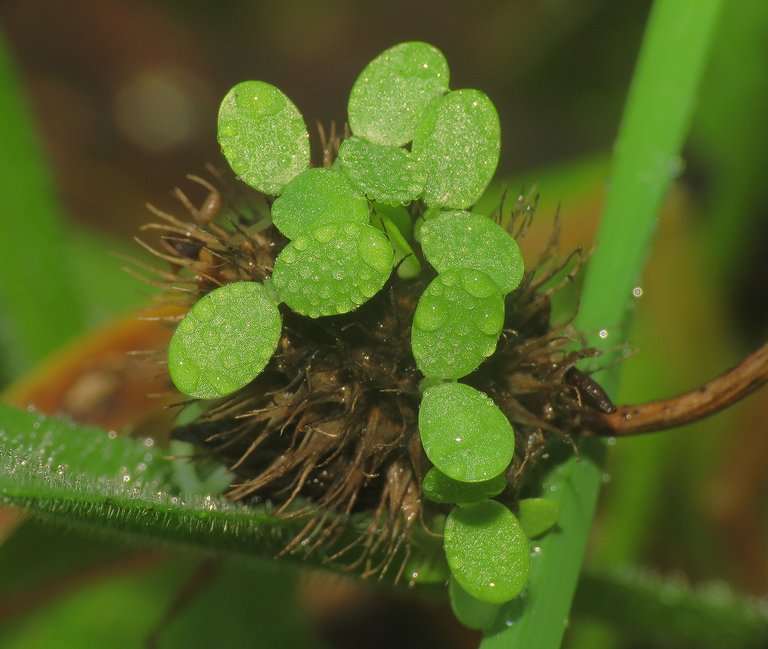

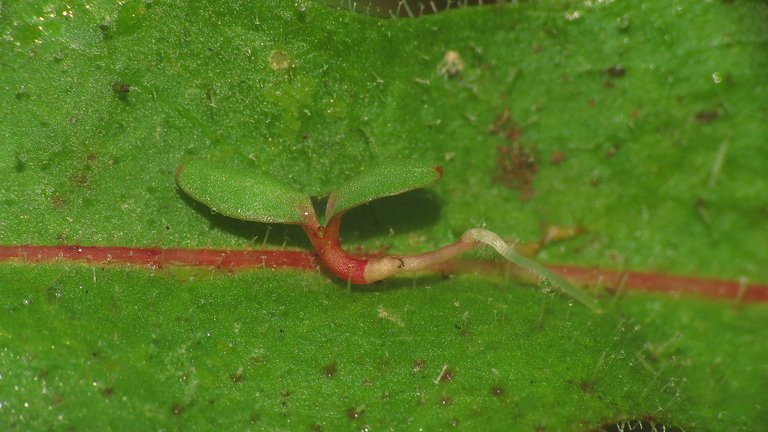


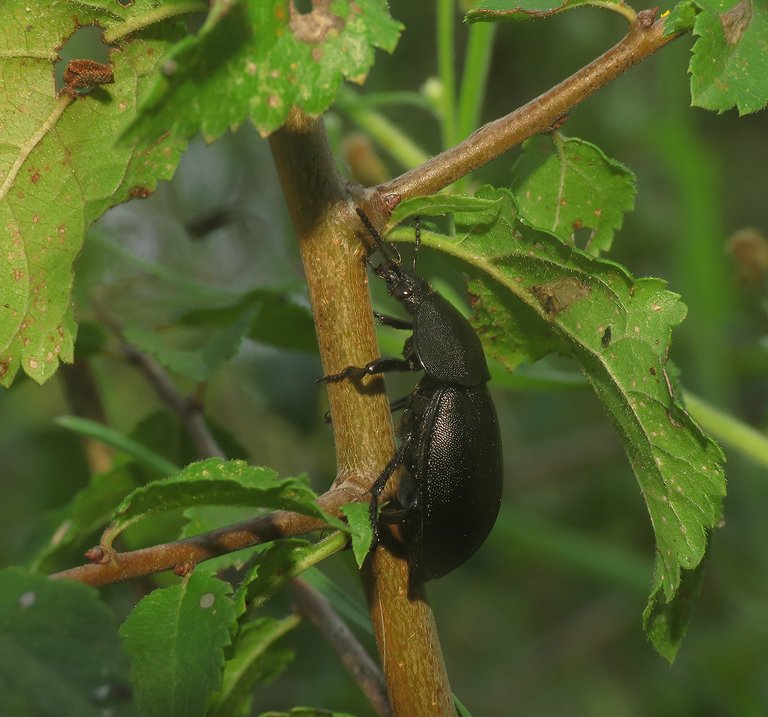

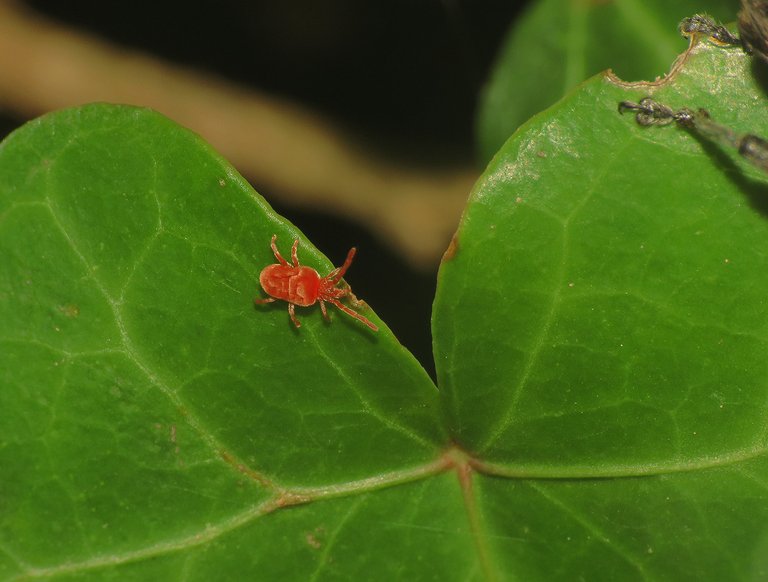

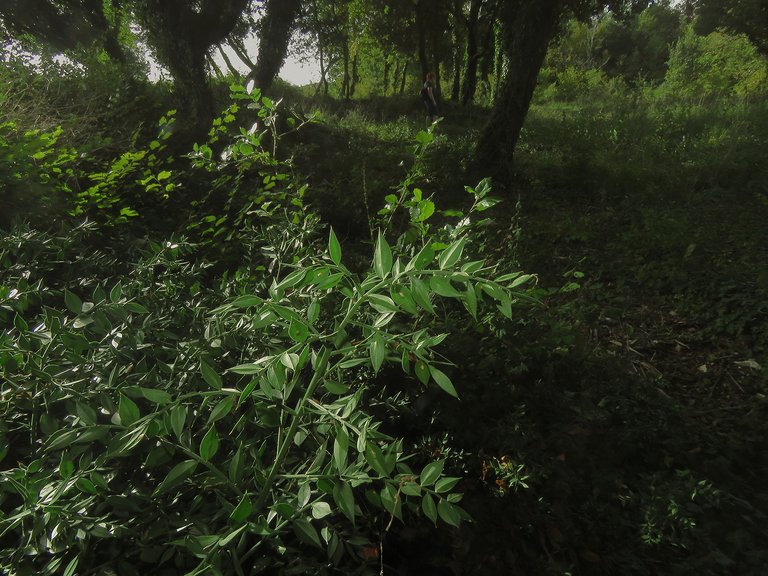
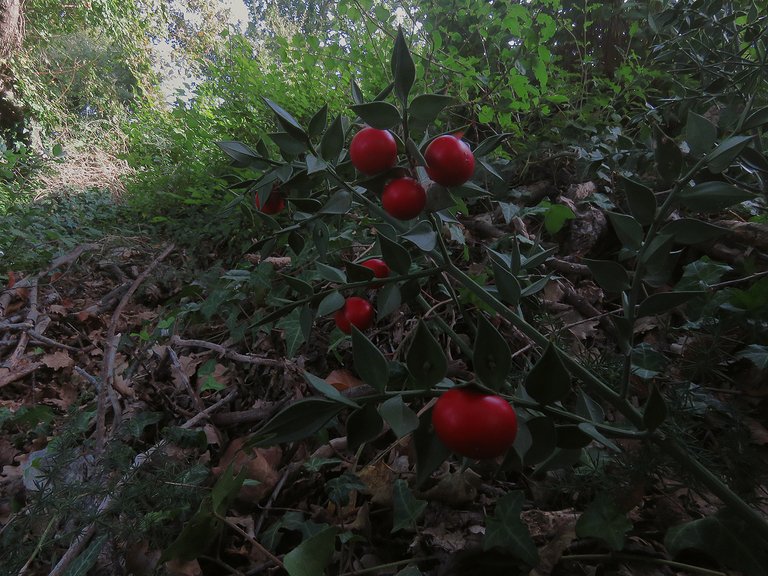
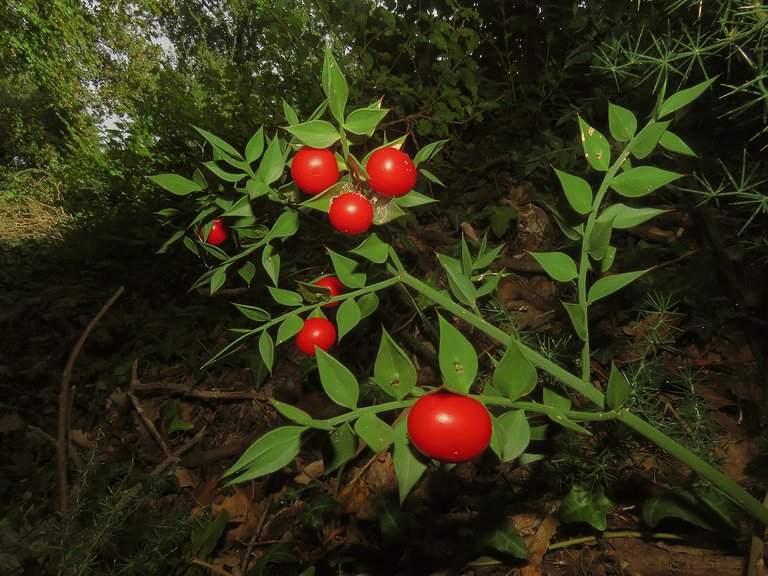
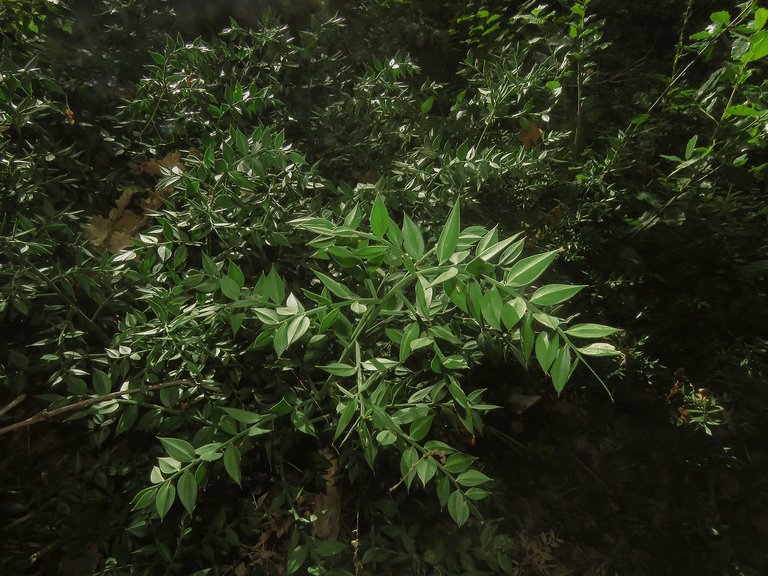
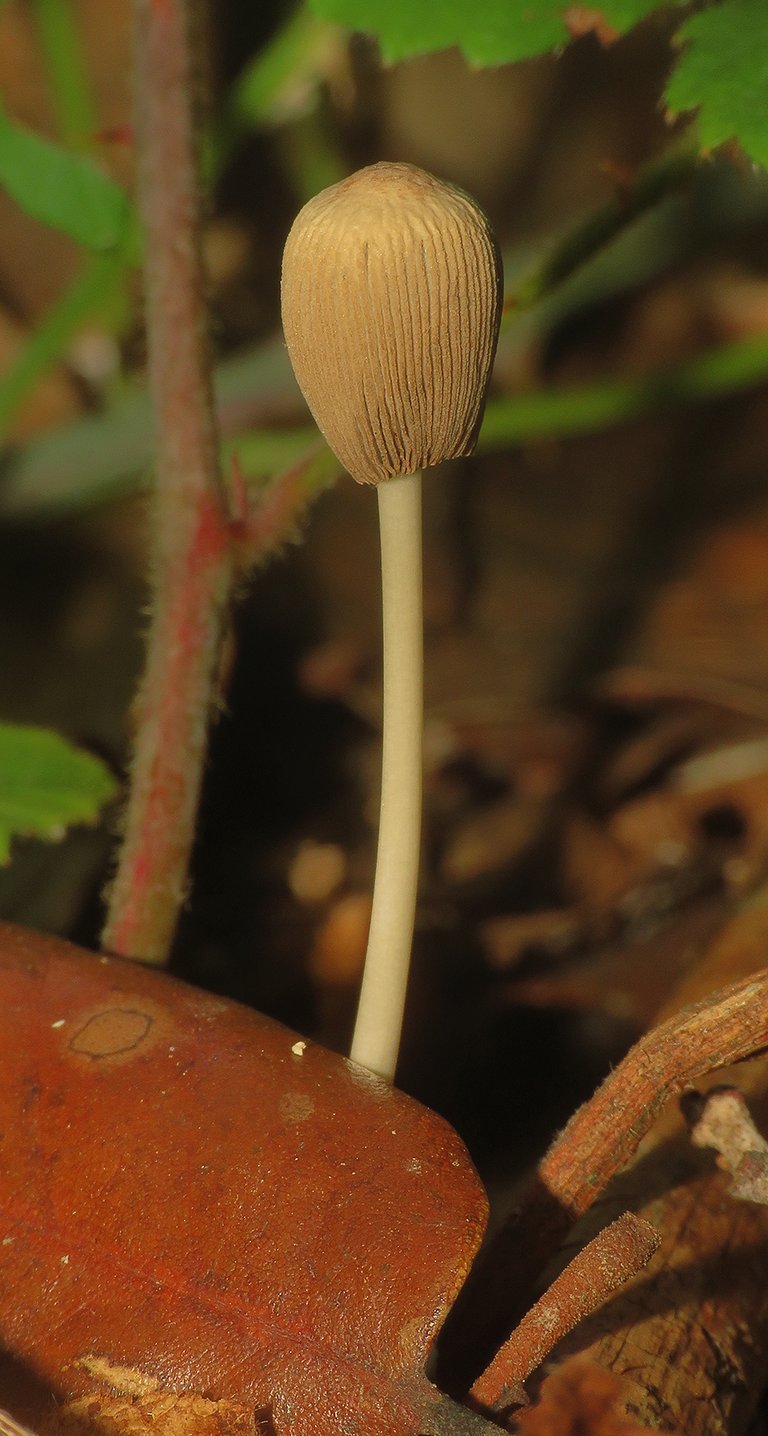



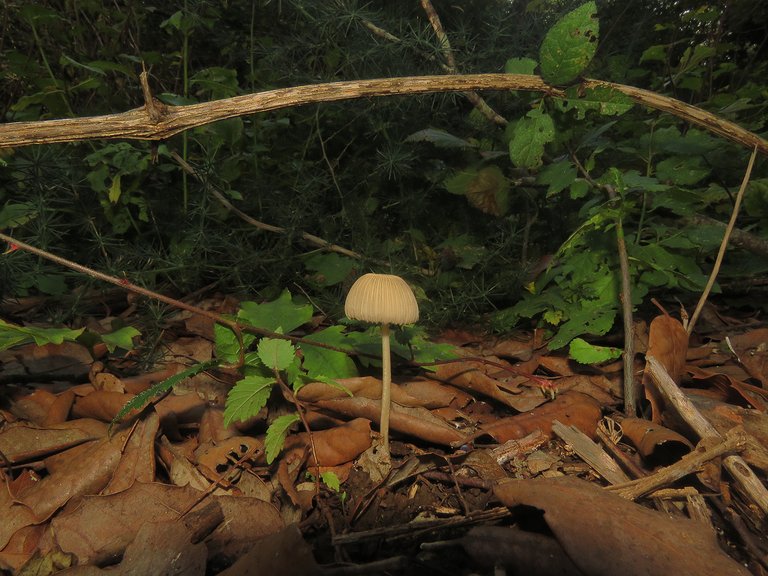

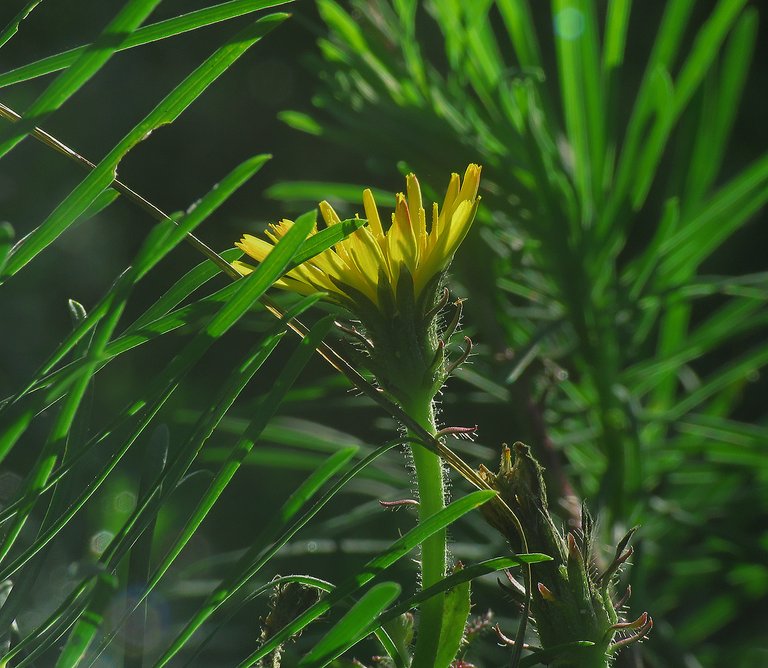
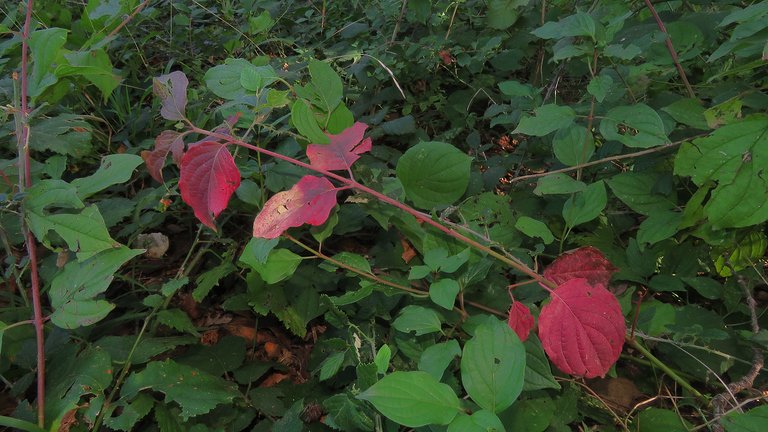
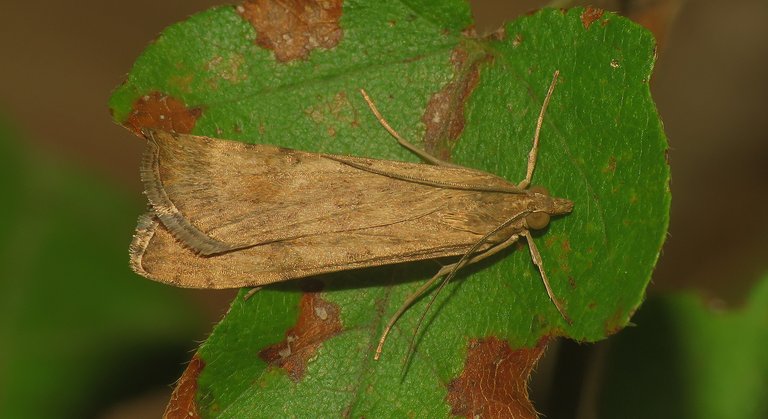
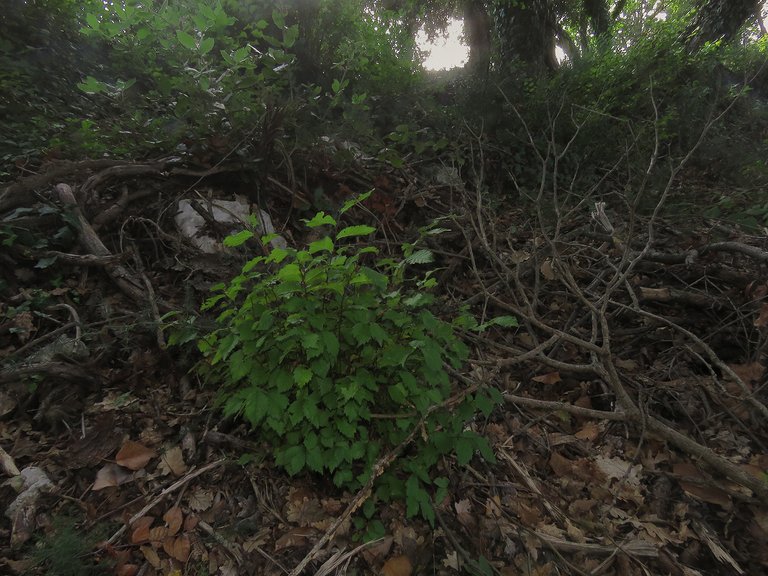

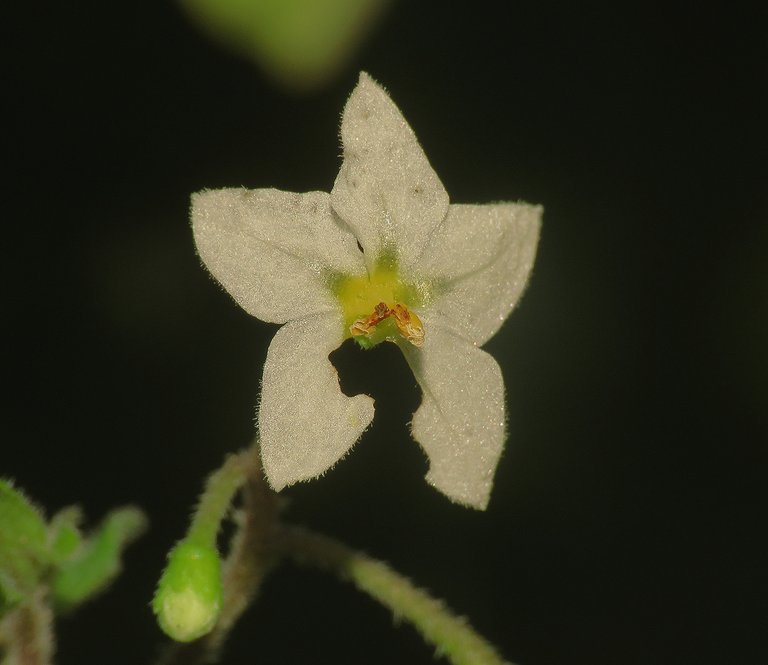
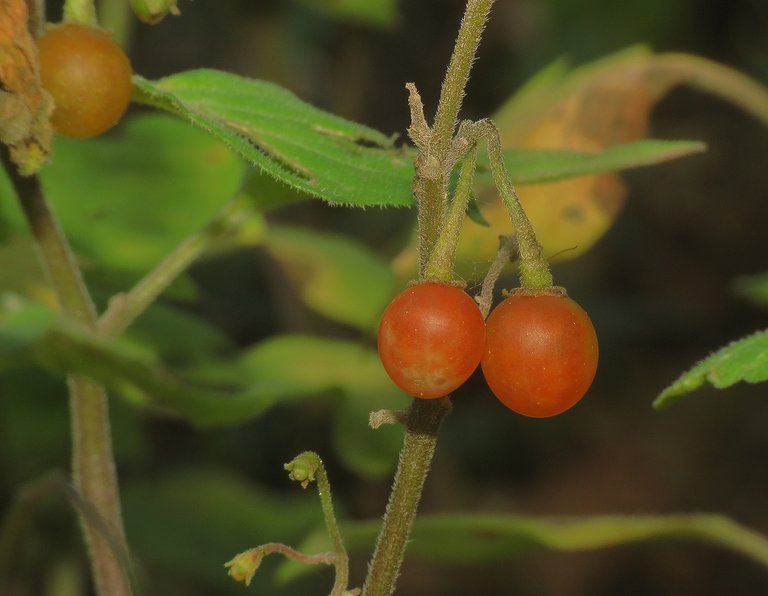


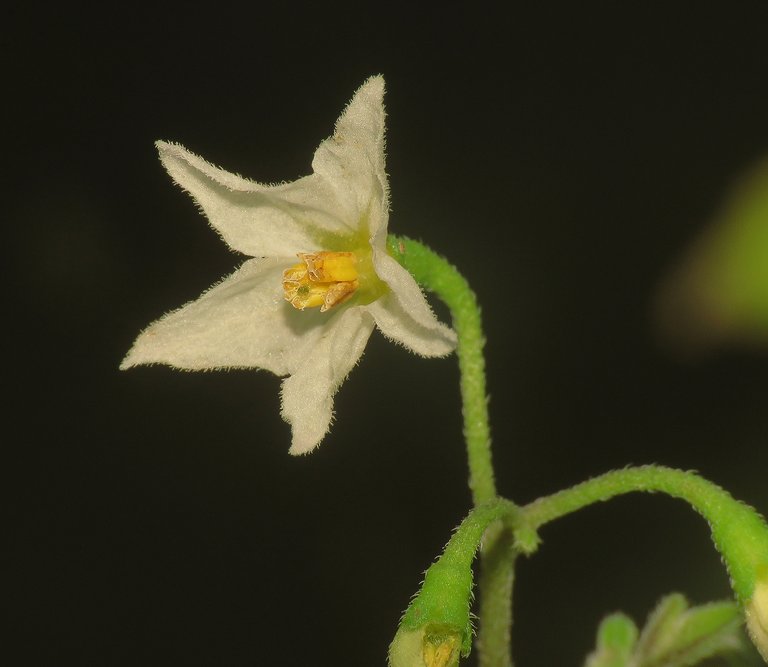
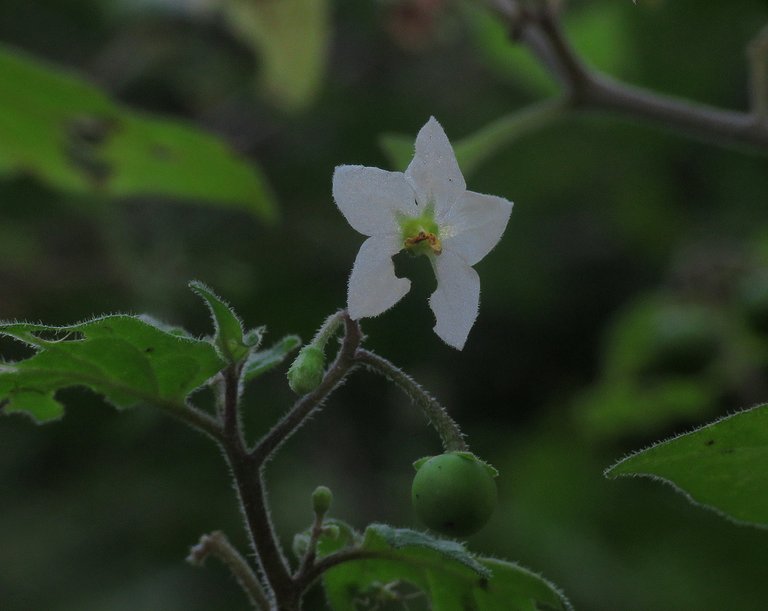


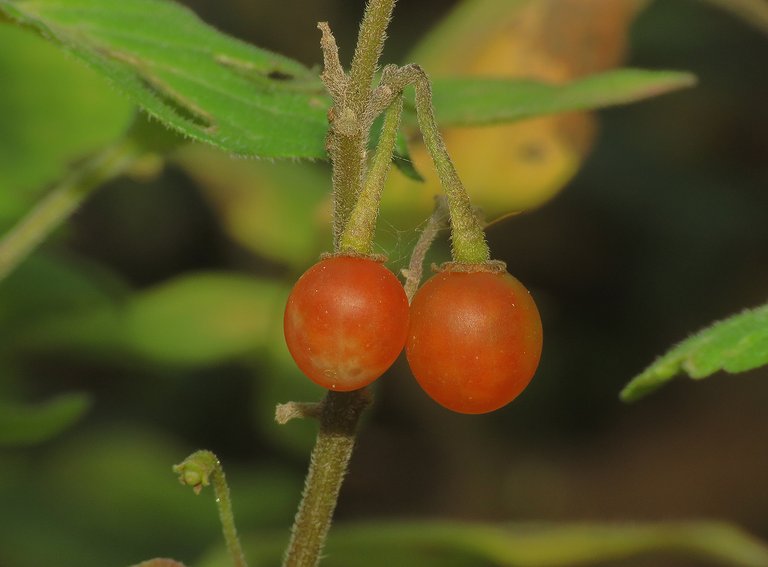
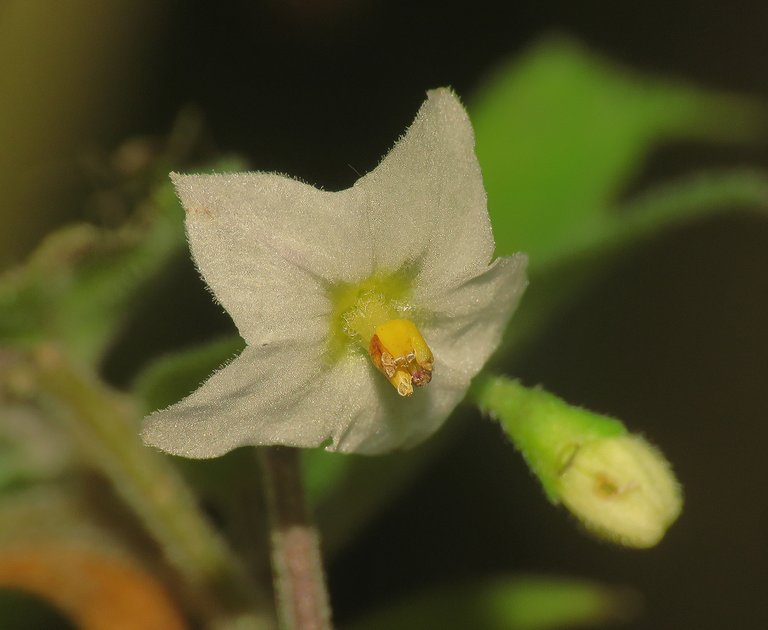
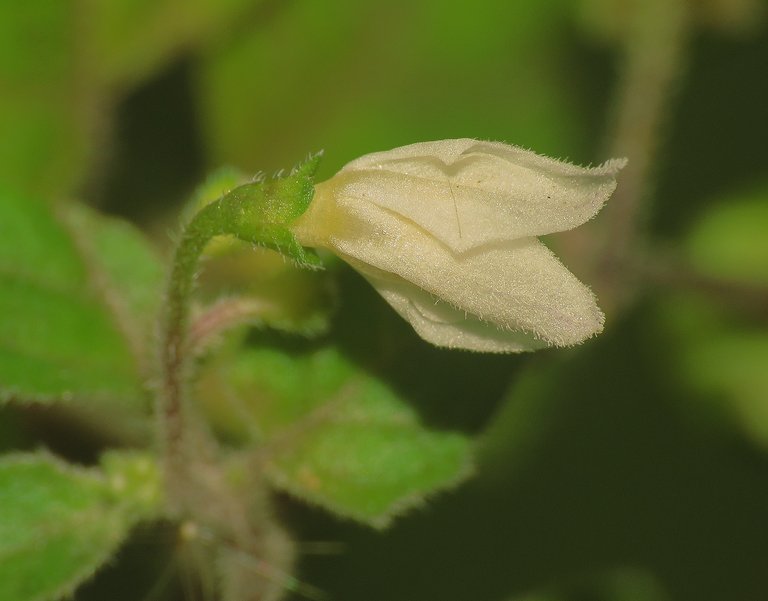
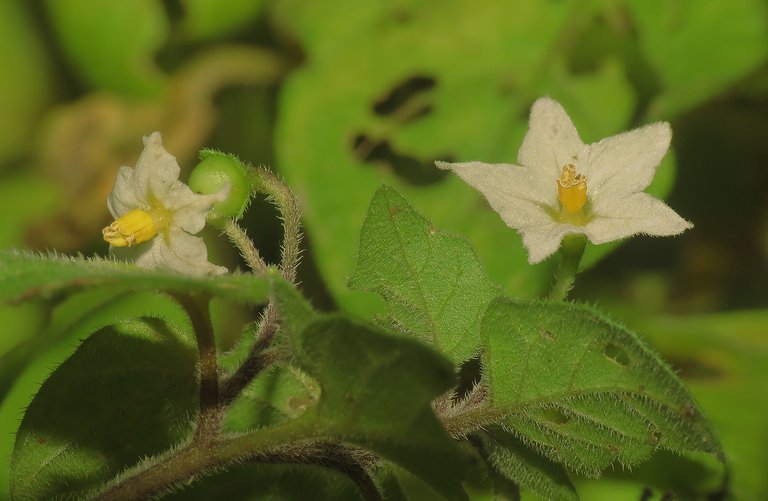

Thank goodness for a good old insect post. D'ya know, I was actually starting to miss them!🙃
😂
We appreciate your work and your publication has been hand selected by the geography curation team on behalf of the Amazing Nature Community. Keep up the good work!
This post was shared and voted inside the discord by the curators team of discovery-it
Join our Community and follow our Curation Trail
Discovery-it is also a Witness, vote for us here
Delegate to us for passive income. Check our 80% fee-back Program
congratulations for getting 73.30 on your post. your hard work payed off !
👍😃👍 Thanks. 😂 It finally happened.
yeah enjoy
Congratulations, your post has been upvoted by @dsc-r2cornell, which is the curating account for @R2cornell's Discord Community.
Always summink different with you :D
It's what I admire about you most. The artist.
Stay you :)
Thank you. 🙂 It's a big compliment.
Well deserved, my friend. It's rare!
At the risk of repeating myself... stay you, please! :)
See you soon!
Hola

@borjan saludos te envía mi amiguita.
👍😀👍
Another one of your wonderful samples of macros in nature... I love to look at this!... Thank you so much for sharing!
!discovery 38
!VSC
!PIZZA
@jlinaresp has sent VSC to @borjan
This post was rewarded with 0.1 VSC to support your work.
Join our photography communityVisual Shots
Check here to view or trade VSC Tokens
Be part of our Curation Trail
@jlinaresp ha enviado VSC a @borjan
Éste post fue recompensado con 0.1 VSC para apoyar tu trabajo.
Únete a nuestra comunidad de fotografía Visual Shots
Consulte aquí para ver o intercambiar VSC Tokens
Se parte de nuestro Trail de Curación
Those close-up shots are both exciting and terrifying, lol! Not sure if that makes sense but while I absolutely love the details, equally I'm scared by those little buddies that don't look so scary from the distance 😂
🐞🕷️😀🪳🐞
That agyrodes is a christmas light bulb!
😃 True, it looks like a Christmas spider that spins Snowflake decorations and hangs on the Christmas tree lika a bulb. ❄️🕸️🕷️🕸️❄️
😆
https://reddit.com/r/blogs/comments/196kz1u/afternoon_on_the_edge_of_the_woods_macro/
The rewards earned on this comment will go directly to the people( @jlinaresp ) sharing the post on Reddit as long as they are registered with @poshtoken. Sign up at https://hiveposh.com.
Awesome bro, you put Entomology and Botany together, if someone want to learn both he or she should visit your blogs.
Every image shows a different story.
!LUV it.
Thank you 🙂 Glad you like the post.
This was a very lengthy read, but it was all worth it, the photographs are all amazing and I love the bugs pictures and spider pictures the more.
Going through your post I could actually witness a lesson on the study of insects and not only, the attached pictures are amazing you are very attentive to detail.
By the way, I saw that you photographed a lot of spiders, I remember reading somewhere that if spiders starve they lose their sight.
Interesting, didn't know that about spiders.
You're welcome.
Omg...all pictures are incredible 👍
It's clear you had great fun in October 2023, I mean taking a leisurely work, soaking up the beauty of the natural environment around and also got some fascinating bug and plant pictures to share with us. May all the months of 2024 be even more fun for you than those of the past year. Thanks for sharing.
The best thing you can do if you have the necessary time is to spend your days outdoors, breathe pure air, and enjoy being close to nature, it is very healthy.
What beautiful varieties of insects that you have been able to find, your shots are really beautiful, the shots you have taken with a macro lens of the leaves and their countless water droplets is wonderful.
This place is a natural paradise, full of plants, insects, even beautiful mushrooms.
Thank you very much dear friend @borjan for sharing this experience in this beautiful natural paradise
I was actually trying to choose my favorite shot but unfortunately, I could not
The shots are really beautiful that I’m finishing it hard to choose a particular one
I love them and keep up the good work
I love the amount of green you have in the post!
The spiders...well I don't like them all that much! Shit scared of them!!!
I agree, October 2023 was indeed great even for me.
Wonderful photos, I think you should start selling it on some site , like pexel ?🤔
Though I don't know how 🤣
por fin mis amados insectos, fue un excelente trabajo que isiste ese día de Octubre..
Taking a walk outdoors is usually refreshing. Nice photos by the way, thanks for sharing them with us.
Really love the clos-ups of all the different insects! Definitely a great post! :D
macro photography is really amazing.
#hive #posh
Soon, in coming spring months, we'll again have the chance to observe nature in it's full beauty. 🌸🪰🦟🥀🪱🌼🪳🕷️🦗🐞🪲
Love the different species of spiders and how they blend with their environment, lots of greenery in the woods!
Amazing photography :)
Oh! How I missed the view of this beautiful insects and plants from you. Always speaking about nature and of course what else is more than the amazing view of nature. These are beautiful, I love the leaves of the Verbascum densiflorum plant.
You're photo collection is just amazing 🤩
Such natural sights and natural things are loved by all of us, the first picture is very special and beautiful and by going to such places, a person forgets his troubles by seeing such things. By reading the posts of now our knowledge is also increasing a lot
$PIZZA slices delivered:
@jlinaresp(4/10) tipped @borjan
Loved the gold texture on the Longitarsus exoletus.
Amazing shots! All the photos are just so beautiful.
It's amazing that you had the scientific names of the insects and plants.
You really took amazing shot I must acknowledge
Time spending with such pretty creatures always feels fresh. Beetles looks so beautiful and their shiny skin just waooo.
It's adorable, somehow insects makes me scared but pretty cute . That's informative Wonder full
Beautiful photography
These are really amazing pictures 🖼️🤩
Such amazing insects, I liked the spiders and the black beetle!
All photos are beautiful, but for me it would be a bit scary to take shots of spiders from such a lose range. I don't think I could do that at all 😅🕷️🕸️
Beautiful nature images. Thanks for your post, @borjan i veliki pozdrav u prelijepu Istru!
Hvala. 🙂 I veliki pozdrav. Glad you like the post.